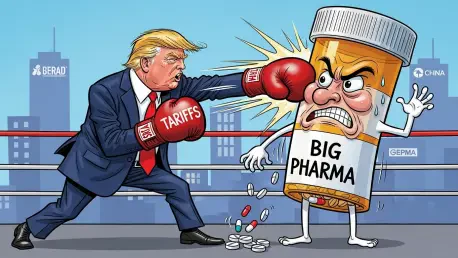In a landscape where the cost of prescription drugs continues to burden American households, President Trump’s aggressive tariff threats have emerged as a powerful tool to reshape the pharmaceutical industry, sparking intense debate. With millions of patients grappling with skyrocketing prices, the administration’s strategy of leveraging tariffs to push for lower drug costs and domestic manufacturing has become a focal point of discussion. This roundup dives into a collection of perspectives from industry analysts, corporate leaders, and policy experts to explore how these tariff-driven negotiations are transforming Big Pharma. The purpose is to distill diverse opinions and insights, providing a comprehensive view of the challenges, opportunities, and implications for the future of healthcare in the U.S.
Understanding the Tariff Strategy and Its Stakes
Policy as a Catalyst for Change
The core of Trump’s approach lies in using tariff exemptions under Section 232 investigations as leverage to compel pharmaceutical giants to negotiate. Industry observers note that the administration’s push for Most Favored Nation (MFN) pricing aims to align U.S. drug costs with lower international rates, a move seen as both ambitious and contentious. This policy, paired with mandates for onshoring production, seeks to address not only affordability but also the vulnerability of supply chains exposed during global disruptions.
Many analysts highlight the high stakes involved in this strategy. Beyond immediate price reductions, the focus on domestic manufacturing is framed as a national security priority, ensuring access to critical medications without reliance on foreign sources. However, there’s shared concern about the feasibility of such sweeping changes in a globally integrated market, setting the stage for varied reactions across the sector.
Corporate Commitments Under Scrutiny
Pharmaceutical companies have responded with significant financial pledges to secure tariff relief, reflecting a pragmatic approach to compliance. Reports indicate that major players like Pfizer, with a $70 billion commitment, and AstraZeneca, investing $50 billion, have moved swiftly to align with policy demands by boosting U.S.-based operations. These actions are often viewed as a strategic compromise to maintain market access while navigating regulatory pressures.
Yet, not all responses are uniform, as some firms remain in ongoing discussions with the administration. Industry watchers point out that while certain companies have finalized deals, others are still grappling with the balance between profitability and policy adherence. This disparity underscores a broader tension: the extent to which corporate giants can sustain price cuts without impacting innovation budgets.
Diverse Perspectives on Tariff-Driven Negotiations
Pricing Reforms: A Win or a Temporary Fix?
On the topic of drug pricing, opinions among analysts are split. Some industry experts argue that the tariff exemptions tied to price reductions represent a rare victory for American consumers, with companies like Eli Lilly committing $27 billion in exchange for relief. This perspective emphasizes the immediate relief for patients burdened by high costs, viewing the negotiations as a step toward broader affordability.
Conversely, skepticism persists about the long-term impact of these concessions. Certain commentators caution that price cuts may be short-lived if companies face shareholder pushback or if policy enforcement weakens over time. There’s a recurring question of whether these reforms address systemic pricing issues or merely serve as temporary bandages in a complex healthcare system.
A third viewpoint suggests a middle ground, where the success of pricing reforms hinges on continuous oversight. Insights from market analysts stress the need for robust mechanisms to ensure compliance, warning that without sustained pressure, pharmaceutical firms might revert to prior pricing models once tariff relief expires.
Onshoring Production: Strategic Advantage or Costly Shift?
The drive to onshore manufacturing has elicited a range of reactions, with many praising the potential for job creation and supply chain resilience. Observers point to commitments like Novo Nordisk’s $10 billion investment in U.S. facilities as evidence of tangible benefits, including thousands of new jobs and reduced dependence on overseas production. Proponents argue this shift strengthens national preparedness for future crises.
However, critics highlight the economic drawbacks of such a transition. Higher operational costs in the U.S. compared to other regions could strain company finances, potentially offsetting the benefits of localized production. Some analysts warn that an overemphasis on domestic manufacturing might limit access to cost-effective global resources, impacting overall efficiency.
Another angle focuses on the role of contract development and manufacturing organizations (CDMOs) in facilitating this shift. Industry insights suggest that CDMOs are becoming indispensable partners, enabling firms to scale operations quickly while meeting policy mandates. Yet, there’s caution about possible vulnerabilities in quality control or delivery timelines when relying heavily on external partners.
Political Influence Over Industry Growth
A growing consensus among healthcare analysts points to a profound shift in how pharmaceutical growth is determined. Rather than being driven solely by scientific breakthroughs, expansion increasingly depends on geographic and political factors due to Trump’s policies. This observation reflects a broader trend where compliance with domestic mandates shapes corporate strategies more than traditional R&D priorities.
Differing corporate responses add nuance to this narrative. While some companies have adapted rapidly to secure tariff exemptions, others face prolonged negotiations, revealing uneven impacts across the sector. Industry leaders note that public critiques from the administration, dismissing certain investments as insufficient, signal an expectation of even larger commitments moving forward.
Policy experts also weigh in, suggesting that this political pressure could redefine global partnerships. There’s speculation that a sustained focus on domestic priorities might strain relationships with international stakeholders, prompting a reevaluation of how firms balance U.S. demands with their worldwide operations. This dynamic remains a critical point of discussion.
Key Takeaways from the Roundup
Reflecting on the diverse opinions gathered, it’s evident that Trump’s tariff threats have sparked a transformative moment for Big Pharma in the U.S. The negotiations have led to immediate outcomes like lowered drug prices and bolstered domestic manufacturing, yet they also introduce uncertainties about long-term sustainability. Differing views on pricing reforms, onshoring challenges, and political influences paint a complex picture of an industry at a crossroads.
For those navigating this evolving landscape, actionable steps emerge from the discourse. Pharmaceutical leaders could focus on integrating flexible strategies to meet policy demands while preserving global competitiveness. Exploring partnerships with CDMOs might offer a practical solution to scale U.S. operations efficiently. Additionally, staying informed about policy shifts and advocating for balanced pricing models could position stakeholders to adapt proactively.
Looking ahead, a deeper dive into regional manufacturing trends or specific case studies of corporate-policy alignments could provide further clarity. Engaging with resources on healthcare policy developments or industry reports might equip readers to anticipate the next wave of changes. This roundup has laid the groundwork, but the conversation on Big Pharma’s future in the U.S. remains open for exploration.









